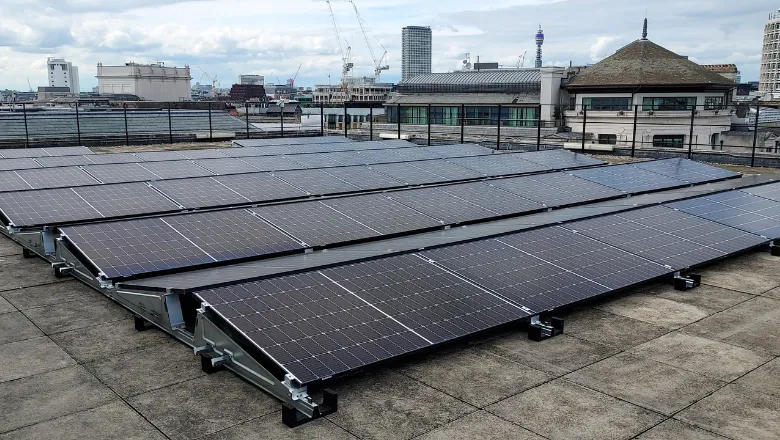These latest accomplishments are a small step along the journey to improve our energy efficiency at King’s. Whilst we are pleased these projects have been completed, we do not rest on our laurels as we continue to ramp up our efforts to reduce King’s energy consumption. It’s important to note that there is much more work to be done, and we have a number of exciting projects which we are looking forward to seeing through to fruition.
Julie Allen, Heat Decarbonisation Programme Lead – Asset Delivery
14 December 2023
Bush House solar panel installation leads energy saving projects topped out
The team at Estates & Facilities continue in their march to increase energy efficiency across King’s with a couple of multi-year projects topping out as we near the end of 2023.

Headlining these successes is a brand-new solar panel PV array on the roof of Bush House, one of King’s flagship buildings at its London Strand campus. The solar array features the latest state-of-the-art panels which are lighter and more efficient than previous iterations.
Due to its location in the heart of central London, it was a big achievement to get the project off the ground, including lengthy processes to receive planning permissions from Westminster Council, plus the COVID-19 pandemic hiccups along the way.
The PV array consists of 64 individual solar panels, which produces 26.24kW of power, equating to 43,329.58 kWh annually, generating enough electricity to power the Vegan Café at Bush House.
The solar array will save approximately 14.7 metric tonnes of CO2 emissions annually, equivalent to the amount of CO2 absorbed by about 674 tree seedlings grown for 10 years. Over its typical 25-year lifespan, it can offset around 350 metric tonnes of CO2 emissions.
There are further plans to install a dashboard in a common area of Bush House, where a live feed will display the power being drawn from these solar panels, which will be completed in 2024.
Elsewhere across the university, a landmark multi-year project at the Denmark Hill campus has reached its conclusion. The project looked to group re-lamp a large-scale number of bulbs across the campus over to LEDs, a proven technology that equates to a 70% reduction of electricity.
The re-lamping work took place at the Cicely Saunders Institute (CSI), Respiratory Medicine, Wellcome Foundation Building and the SGDPRC Building, which collectively will save 367,073 KwH, and 97 metric tonnes of CO2 emissions annually.
Julie Allen, ‘Heat Decarbonisation Programme Lead – Asset Delivery’ (Estates & Facilities) said:
King's is committed to achieving improved energy performance in all its operations. The Energy & Carbon Management Policy outlines the university's aims to reduce its energy use and carbon emissions according to the Carbon Management Plan.
King’s have set the target to be a net zero carbon institution by 2030, and to reduce our absolute scope 1, 2 and 3 emissions by 50% by 2030.
These ambitious targets, as well as our plans to work towards are outlined in our Climate & Sustainability Action Plan, which has been co-created with students and staff in King's Climate Action Network.
